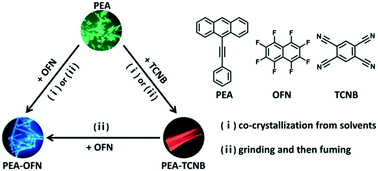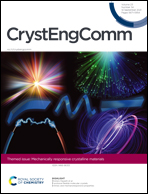Supramolecular complex strategy for pure organic multi-color luminescent materials and stimuli-responsive luminescence switching†
Abstract
Pure organic multi-color luminescent materials were developed using a supramolecular complex strategy based on a high-efficiency blue-emitting anthracene derivative, in which the emission color can be finely tuned from blue through green to red due to the different co-former compositions and stacking modes in the crystal. Experimental and theoretical investigations demonstrate that the excited-state characteristics are essentially responsible for multi-color fluorescence emission with tunable lifetime and efficiency, corresponding to the different excited-state species (e.g., monomer, excimer-like aggregate and exciplex) in the crystals, respectively. Meanwhile, these supramolecular complexes exhibit intriguing mechanochromic and solvent-induced luminescence switching in the stimuli-responsive field. This work not only provides a better understanding of the structure–property relationship between intermolecular complexes and fluorescence properties, but also suggests a feasible strategy to develop a new class of organic solid-state luminescent materials with multi-color fluorescence.

- This article is part of the themed collections: Supramolecular & Polymorphism and Mechanically responsive crystalline materials


 Please wait while we load your content...
Please wait while we load your content...